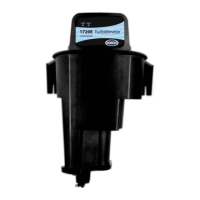Operation
35
ACTIVATION
Function set to ALARM
LOW ALARM
Sets the value where the relay will turn on in response to decreasing measured value. For example: if the
low alarm is set for 1.0 and the measured value drops to 0.9, the relay will be activated.
Range: 0.00–100 NTU
HIGH ALARM
Sets the value where the relay will turn on in response to increasing measured value. For example: if the
high alarm is set for 4.0 and the measured value increases to 4.2, the relay will be activated.
Range: 0.00–100 NTU
LOW DEADBAND
Sets the range where the relay remains on after the measured value increases above the low alarm value.
Default is 20% of the range. For example: if the low alarm is set for 1.0 and the low deadband is set for 0.5,
then the relay remains on between 1.5 and 1.0. Range: 0.00–100 NTU
HIGH DEADBAND
Sets the range where the relay remains on after the measured value decreases below the high alarm value.
For example: if the high alarm is set for 4.0 and the high deadband is set for 0.5, then the relay remains on
between 3.5 and 4.0. Range: 0.00–100 NTU
OFF DELAY Sets a time to delay the relay from normally turning off. Off Delay Range: 0–999 seconds
ON DELAY Sets a time to delay the relay from normally turning on. On Delay Range: 0–999 seconds
Function set to FEEDER CONTROL
PHASE
“High” phase assigns the relay setpoint to respond to an increasing measured value; conversely, a “Low”
phase assigns the relay setpoint to respond to a decreasing measured value.
SET SETPOINT Sets the value where the relay will turn on. Default: 100 NTU; Range: 0–100
DEADBAND
Sets the range where the relay remains on after the measured value decreases below the setpoint value
(high phase relay) or increases above the setpoint value (low phase relay). Default: 5 NTU;
Range: 0–100 NTU
OVERFEED
TIMER
Sets the time to limit how long the relay can remain “on.” Default: 5 minutes; Range: 0–999 minutes
OFF DELAY Sets a time to delay the relay from normally turning off. Default: 0 seconds; Range: 0–999 seconds
ON DELAY Sets a time to delay the relay from normally turning on. Default: 0 seconds; Range: 0–999 seconds
Function set to EVENT CONTROL
PHASE
“High” phase assigns the relay setpoint to respond to increasing measured value; conversely, a “Low” phase
assigns the relay setpoint to respond to decreasing measured value.
SET SETPOINT Sets the value where the relay will turn on. Default: 100; Range: 0–100
DEADBAND
Sets the range where the relay remains on after the measured value decreases below the setpoint value
(high phase relay) or increases above the setpoint value (low phase relay). Default: 5 NTU;
Range: 0–100 NTU,
OnMax TIMER Sets the time to limit the time the relay can remain “on.” Default: 0 seconds; Range: 0–999 seconds
OffMax TIMER Sets a time to delay the relay from normally turning off. Default: 0 seconds; Range: 0–999 seconds
OnMin TIMER Sets the time to limit the time the relay can remain “on.” Default: 0 seconds; Range: 0–999 seconds
OffMin TIMER Sets the time to limit the time the relay can remain “off.” Default: 0 seconds; Range: 0–999 seconds
Function set to TIMER CONTROL (RTC selected in SELECT SOURCE)
HOLD OUTPUTS Set OUTMODE to select output hold operation and select the channels that cause the outputs to be held.
INTERVAL Set the off time for the relay. Default: 5 minutes; Range: 0–999 minutes
DURATION Set the on time for the relay. Default: 30 seconds; Range: 0–999 seconds
OFF DELAY
Set the time for additional hold/output time after the relay has been turned off. Default: 1 second;
Range: 0–999 seconds
Function set to WARNING CONTROL
WARNING LEVEL
Set the warning level that will trigger a relay. Range: 0–32 (warnings assigned to 1-9 for 1720E). For
example: Set the warning level to 0 to allow all warnings to trigger the relay; set the warning level to 5 to
allow warnings 6 and above to trigger the relay. Set the warning level to 9 or greater to not trigger the relay
on any warning. See Table 10 on page 52 for a full list of warnings.
4.6.1 Relay Setup Menu (from System Setup) (continued)

